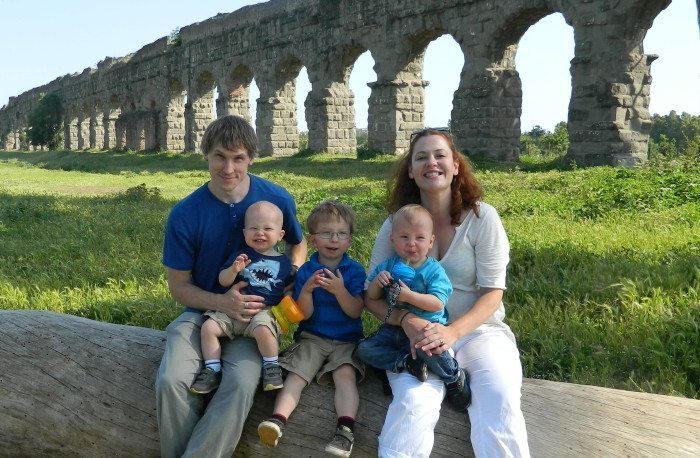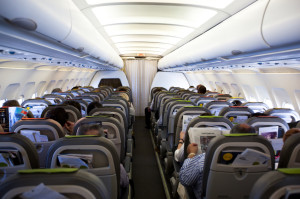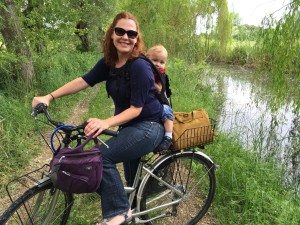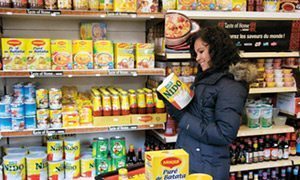Last updated on September 30th, 2021 at 10:17 am
I hear a lot of moms of multiples expressing how difficult it is for them to find the time to take a shower, let alone make a trip to a large grocery store like Costco. They think that their travel and adventuring days are behind them — but I promise that they are not. I am a stay at home mom to 3 adorably rambunctious boys. My oldest is almost 4, and my twins are 19 months. My oldest has taken several trips abroad with us; but this spring was the first time the twins got their very first passport stamp.
As with all things that relate to your multiples, the key is good planning. Gone are the times when you could on a whim, buy a ticket a month in advance and be off. Think about how much planning is involved in going on that weekly shopping trip and multiply that by infinity.
 The flight
The flight
Pick your flight out to have as few connections as possible. Having one long haul flight coupled with a connected to short inter-country flight is preferable. Schedule the flight out to start a few hours before bedtime in your time zone and to arrive at your destination in the morning or no later than mid-day. This will instantly acclimate your kids to the new time change. Try and do the same with the flight home.
If you are flying with a partner of the airline that you purchased your ticket from or you bought your ticket with a website like Travelocity, make sure you call the airline you are flying with directly to arrange special meals (including kid’s meals), seats, baby bassinets (call the airline as far in advance as you can to find out the weight restrictions and to book them if need be, as there are only 4-8 in economy and they book up incredibly fast), and making sure that any lap infants that you might have are added to your itinerary.
The flight can be traumatic if not planned for properly. Bring a small backpack for each child with a few brand new toys and books to pop out during the flight. Even if you are against television for children; loading 10 plus hours of an assortment of PBS Kids options to any handheld media device (with headphones) are a blessing. The calmer they are the less stressful it is for them, you, and the entire plane full of tired travelers. All international flights have milk, juice, and baby food on board. Do not feel bad about asking the flight attendant to refill your child’s cup or bottle for the hundredth time. They are more than happy to do so.
[Twiniversity tip: Hand out small goodie bags to the people around your seats, such as a small bag of Hershey kisses and foam earplugs with a little note of thanks, to win them over for the flight.]
 Accommodation
Accommodation
A small hotel room or even a suite will not fit a family of 6. Consider renting an apartment instead. Sites like airbnb.com and VRBO.com are great for this. You can rent an apartment or house directly from the owner for a few days, weeks, or months. Never stay in a place that hasn’t been reviewed before; make sure that you have a way to contact the landlord outside of the site just in case and ask a lot of questions. The more space you have, the happier your children will be. They need space from each other and sometimes you.
Gear
Many sights are either too difficult to traverse with a stroller or strollers are not allowed. If your children are under bring compact soft backpack carriers; like Boba, or Ergo. For when strollers are possible consider a tandem twin stroller like the Kinderwagon Hop. Streets in older cities are paved with cobblestones with very narrow roadways that you share with cars. You want to take up as little space as possible.
 Destination
Destination
Research the country that you are going to be visiting. Are they a family friendly culture? Italians will hug, kiss, and squeeze the cheeks of your kids in the streets, the Spanish take their kids everywhere and kids are welcome in almost every restaurant, but London with its huge population of busy commuters and crowded streets, and constantly dodging bike riders in Amsterdam are going to make young children fearful and uncomfortable. A safari might terrorize a 2 year old, but might be fascinating to a 9 year old. If you have dietary restrictions make sure that you will be able to be accommodated. Learn how to communicate those needs in whatever language the residents speak.
Lower your expectations regarding the amount of museums and sites that you are going to be able to visit on a daily basis. Your children have a limited tolerance for seeing the sights. Once that tolerance expires it will not be pleasant for anyone and you will be likely asked to leave. Meticulously plan each day; down to the form of public transportation you will take and from where. Your kids will get tired of you walking around lost, or waiting at the bus stop for 40 minutes. Download an offline map app like pocket earth for any cities you will visit, and buy some data for your phone from your regular carrier so that you can use google maps in a pinch when out and about. If you are taking a day trip away from your home base; pick your top 3 sights, plan your route and only deviate from that plan to see other things once you have visited all 3. Otherwise you may miss the thing you were most excited about because you wasted time at that tourist shop, or ancient building facade.
If you can afford to; bring an extra pair of hands. Perhaps a niece, family friend or your regular babysitter. You don’t have to go broke. Offer to pay their way, give them one day off a week (for trips a week or longer), and $500 for spending money. The most important thing is to clearly go over your expectations beforehand. This is your vacation; their job. If your family is very athletic and like to climb towers, cathedral domes, or go on long hikes; make sure that they would be able to handle that with a child strapped to their back. Just because you can do it, and you do it on a daily basis does not mean that your average person will be able to. It is important that they have a level of maturity to be able to navigate a strange city by themselves, and stay at the apartment all day with your kids (should you choose to make a day trip). With this extra set of hands you will be able to split up your day with family time; and you and your partner going out to visit the less child friendly places museums, and fancy dinners.
 Meals
Meals
Eating meals at home, and packing a lunch each day can lower your costs considerably and be a huge time saver. Your kids will not have to sit through a French lunch (a few hours). Google map where the nearest large supermarket is to your home base. Be aware many European grocery stores either no longer have plastic and paper shopping bags, or charge you for them. Bring a few sturdy reusable shopping bags in your suitcase. While shopping watch the locals and do as they do. Don’t be that person who is getting yelled at by an elderly lady in a language that you do not understand because you didn’t put gloves on when touching the fruit and vegetables. Be aware; you may not find many things that you are used to. Each country is different, but peanut butter is always very hard to find wherever you go. Frozen waffles are unheard of in many countries. If your child is a picky eater; start introducing foods that you will likely be eating while abroad and keep them on your menu planner until you leave. My twins only ate yogurt or toaster waffles for breakfast before our recent trip. I started introducing eggs 3 days a week six months before we left.
Hopefully some of these tips will help to ensure you that foreign travel is not a thing of the past and help you and your family plan your next big adventure.



 The flight
The flight Accommodation
Accommodation Destination
Destination Meals
Meals




